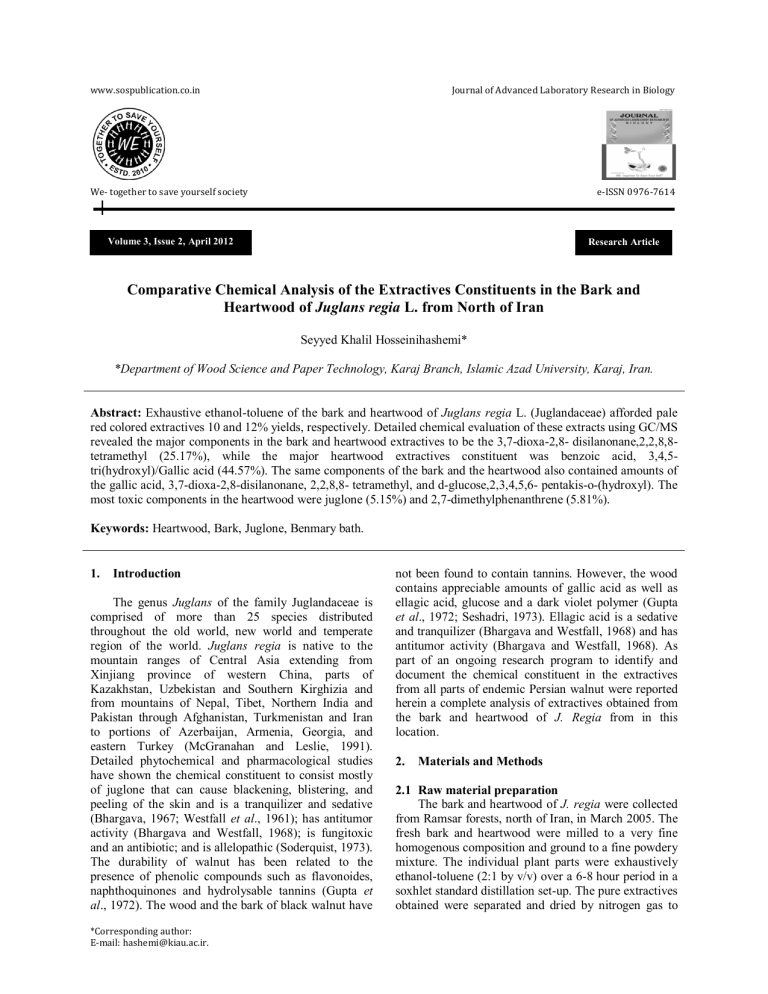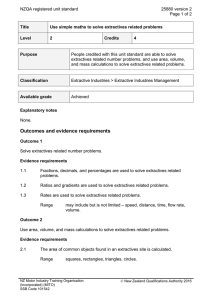Comparative Chemical Analysis of the Extractives Constituents in the Bark and Heartwood of Juglans regia L. from North of Iran
advertisement

www.sospublication.co.in Journal of Advanced Laboratory Research in Biology We- together to save yourself society e-ISSN 0976-7614 Volume 3, Issue 2, April 2012 Research Article Comparative Chemical Analysis of the Extractives Constituents in the Bark and Heartwood of Juglans regia L. from North of Iran Seyyed Khalil Hosseinihashemi* *Department of Wood Science and Paper Technology, Karaj Branch, Islamic Azad University, Karaj, Iran. Abstract: Exhaustive ethanol-toluene of the bark and heartwood of Juglans regia L. (Juglandaceae) afforded pale red colored extractives 10 and 12% yields, respectively. Detailed chemical evaluation of these extracts using GC/MS revealed the major components in the bark and heartwood extractives to be the 3,7-dioxa-2,8- disilanonane,2,2,8,8tetramethyl (25.17%), while the major heartwood extractives constituent was benzoic acid, 3,4,5tri(hydroxyl)/Gallic acid (44.57%). The same components of the bark and the heartwood also contained amounts of the gallic acid, 3,7-dioxa-2,8-disilanonane, 2,2,8,8- tetramethyl, and d-glucose,2,3,4,5,6- pentakis-o-(hydroxyl). The most toxic components in the heartwood were juglone (5.15%) and 2,7-dimethylphenanthrene (5.81%). Keywords: Heartwood, Bark, Juglone, Benmary bath. 1. Introduction The genus Juglans of the family Juglandaceae is comprised of more than 25 species distributed throughout the old world, new world and temperate region of the world. Juglans regia is native to the mountain ranges of Central Asia extending from Xinjiang province of western China, parts of Kazakhstan, Uzbekistan and Southern Kirghizia and from mountains of Nepal, Tibet, Northern India and Pakistan through Afghanistan, Turkmenistan and Iran to portions of Azerbaijan, Armenia, Georgia, and eastern Turkey (McGranahan and Leslie, 1991). Detailed phytochemical and pharmacological studies have shown the chemical constituent to consist mostly of juglone that can cause blackening, blistering, and peeling of the skin and is a tranquilizer and sedative (Bhargava, 1967; Westfall et al., 1961); has antitumor activity (Bhargava and Westfall, 1968); is fungitoxic and an antibiotic; and is allelopathic (Soderquist, 1973). The durability of walnut has been related to the presence of phenolic compounds such as flavonoides, naphthoquinones and hydrolysable tannins (Gupta et al., 1972). The wood and the bark of black walnut have *Corresponding author: E-mail: hashemi@kiau.ac.ir. not been found to contain tannins. However, the wood contains appreciable amounts of gallic acid as well as ellagic acid, glucose and a dark violet polymer (Gupta et al., 1972; Seshadri, 1973). Ellagic acid is a sedative and tranquilizer (Bhargava and Westfall, 1968) and has antitumor activity (Bhargava and Westfall, 1968). As part of an ongoing research program to identify and document the chemical constituent in the extractives from all parts of endemic Persian walnut were reported herein a complete analysis of extractives obtained from the bark and heartwood of J. Regia from in this location. 2. Materials and Methods 2.1 Raw material preparation The bark and heartwood of J. regia were collected from Ramsar forests, north of Iran, in March 2005. The fresh bark and heartwood were milled to a very fine homogenous composition and ground to a fine powdery mixture. The individual plant parts were exhaustively ethanol-toluene (2:1 by v/v) over a 6-8 hour period in a soxhlet standard distillation set-up. The pure extractives obtained were separated and dried by nitrogen gas to Comparative Chemical Analysis of the Extractives of J. regia L. give pale red colored extracts in 10 and 12% yields from the bark and heartwood, respectively. In order to identify of extract, about 1mg solid extracts obtained, mixed with 30 microliters BSTFA + 1% TMCS reagent and about 15 microliter pyridine inside tube test. Afterward was placed into the benmary bath with 70°C temperature. The analyses of the extracts were done using GC/MS on an Agilent 6890 Gas Chromatograph, equipped with a split/splitless injector and a 7963 Mass Selective Detector (MSD). The column oven was programmed as follows: Chromatography was performed on an HP-5MS capillary column (SGE, 30m, 0.25mm), kind of carrier gas, helium with 1ml/min speed and temperature program between 60-260°C, increase temperature 6°C/min. 2.2 Identification of extract components The extractives samples were injected into GC/MS apparatus injector portion. The individual compounds in the extractives were identified by their retention time relative to known compounds and further by Seyyed Khalil Hosseinihashemi comparison of their mass spectra with either the known compounds or published spectral data. 3. Result and Discussion Comparative data on the different extractives constituent in the bark and heartwood of J. regia is presented in Table-1, Fig. 1, and 2. The results indicate that gallic acid, 3,7-dioxa-2,8-disilanonane, 2,2,8,8tetramethyl, and D-glucose,2,3,4,5,6-pentakis-o(hydroxyl), present in similar amounts in the bark and heartwood and gallic acid found in the bark extractives in trace amounts. This 2,7-dimethylphenanthrene is an important compound extractive, whose presence in the heartwood has not been reported previously, but 2,7-dimethylphenanthrene -like compounds (naphthalene) has been reported in the fruit extracts of J. regia (Muller and Leistner, 1978; Talapatra et al., 1988). The heartwood extractives also contained small amounts of α-pinene and juglone, which were not found in the bark extractives and cholesterol benzoate and pentacosane are the main constituents of the bark extractives of J. regia whose has not been reported previously and are absent in the heartwood extractives. Fig. 1. GC-MS Chromatogram of ethanol-toluene extractives Juglans regia heartwood. J. Adv. Lab. Res. Biol. 100 Comparative Chemical Analysis of the Extractives of J. regia L. Seyyed Khalil Hosseinihashemi Table 1. A comparative analysis of the composition of the chemical constituent (area %) in the bark and heartwood extractives of J. regia. Chemical component α-pinene Juglone 3,7-dioxa-2,8-disilanonane, 2,2,8,8-tetramethyl Propanoic acid, 2-(trimethylsilyl)oxy-,trimethyl Silane, trimethyl(phenylmethoxy) 3,7-dioxa-2,8-disilanonane, 2,2,8,8-tetramethyl 6-amino-3-cyano-5-methylpyrazine-2-carboxamide Cis-9-oxabicyclo [6.1.0] non-2-yne D-glucose, 2,3,4,5,6-pentakis-o-(hydroxyl) Benzoic acid, 3,4,5-tri(hydroxyl)/Gallic acid 2-butenoic acid, 2-methyl-, 2-propenyl ester Mannose, 2,3,4,5,6,-pentakis-o-(hydroxyl) 2,6,10-timethylundecane-(5z)-2,5,9-trien-4-one 3,8-dioxa-2,9-disiladecane, 2,2,9,9-tetramethyl Butanoic acid, 2,4-bis(hydroxyl)-, trim Dimethyl 8-(tert-butyl)-5,6,10-trim Cholesteryl benzoate 2,7-dimethylphenanthrene Pentacosane 1,2-benzenedicarboxylic acid, diisooctyl ester Xylitol 5-TMS Benzoic acid,3,4-bis(hydroxyl) D-fructose, 1,3,4,5,6-pentakis-o-(hydroxyl) D-glucose, 2,3,4,5,6-pentakis-o-(hydroxyl) Benzoic acid, 3,4,5-tri(hydroxyl)/Gallic acid Retention Time (min.) 5.69 6.02 8.19 8.69 10.66 13.34 13.69 14.54 15.63 16.19 16.36 16.51 16.98 17.81 17.95 18.09 18.15 19.99 20.26 20.31 21.37 22.67 22.87 23.94 24.72 Bark 25.17 5.09 3.88 2.40 4.53 10.28 5.21 4.25 4.06 7.77 5.37 3.72 13.71 - Heartwood 5.28 5.15 1.07 1.33 2.40 2.15 5.81 3.26 2.06 0.79 4 44.57 Fig. 2. GC-MS Chromatogram of ethanol-toluene extractives Juglans regia bark. J. Adv. Lab. Res. Biol. 101 Comparative Chemical Analysis of the Extractives of J. regia L. 4. Conclusion The tree Juglans regia (Persian walnut) (Juglandaceae) is a species endemic island of Iran, from which the gallic acid could be obtained from either common walnut. A comparative study of the bark and heartwood extractives indicates the bark and heartwood extractives to be the main natural sources of the gallic acid and 3,7-dioxa-2,8-disilanonane,2,2,8,8tetramethyl. The juglone and 2,7-dimethylphenanthrene were found to occur as minor constituents in the heartwood extractives. The bark extractives, on the other hand, were found to be composed partially of cholesterol benzoate and pentacosane. References [1]. Bhargava, U.C. (1967). Ph.D. Thesis, Pharmacology of ellagic acid from black walnut. University of Missouri, 670 p. [2]. Bhargava, U.C. & Westfall, B.A. (1968). Antitumor activity of Juglans nigra (black walnut) extractives. Journal of Pharmaceutical Sciences, 57 (10):1674-1677. [3]. Gupta, S.R., Ravindranath, B. & Seshadri, T.R. (1972). Juglandaceae: Polyphenols of Juglans nigra. Photochem., 11: 2634-2636. J. Adv. Lab. Res. Biol. Seyyed Khalil Hosseinihashemi [4]. McGranahan, G. and Leslie, C. (1991). Walnuts (Juglans L.). In Genetic Resources of Temperate Fruit and Nut Crops. J.N. Moore and J.R. Ballington (eds). International Society for Horticultural Science, Wageningen, pp. 907 – 951. [5]. Muller, W.U. & Leistner, E. (1978). Aglycones and glycosides of oxygenated Naphthalenes and a glycosyltransferase from Juglans. Phytochemistry, 17(10): 1739-1742. [6]. Seshadri, T.R. (1973). An investigation of the phenolic constituents of certain woods and barks, including North American species and representatives of genera common to North America and India, (J.W Rowe, USDA PL-480 Proj. FG-In-425 Forest Prod. Lab. Madison Wis.). [7]. Soderquist, C.J. (1973). Juglone and allelopathy. Journal of Chemical Education, 50 (11): pg. 782. [8]. Talapatra, S.K., Karmacharya, B. & Talabatra, B. (1988). Levoregiolone an alpha-tetralone from Juglans regia; Structure, Stereochemistry and confirmation. Phytochemistry, pg. 3929. [9]. Westfall, B.A., Russell, R.L. & Auyong, T.K. (1961). Depressant agent from walnut hulls. Science, 134: 1617. 102



